The Bigrlyi Tabular Sandstone-Hosted Uranium–Vanadium Deposit, Ngalia Basin, Central Australia
Abstract
:1. Introduction
2. Geological Setting
2.1. Ngalia Basin
2.2. Bigrlyi Deposit
3. Materials and Methods
4. Results
4.1. Features of the Host Sandstone
4.2. Distribution of U-V Across the Deposit
4.3. Distribution of U-V in Drill Core and Its Relation to Sedimentology
4.3.1. Drill Core—B07120
4.3.2. Drill Core—B07129
4.4. Mineralogy and Petrology
4.4.1. Uranium-Dominated U-V Mineralization
4.4.2. Vanadium-Dominated U-V Mineralization
4.5. Geochemistry
4.5.1. Geochemical Signature of U-V Mineralization
4.5.2. Organic Carbon
4.5.3. Pb Isotopes
5. Discussion
5.1. Pb-Isotope Constraints on U-Mobility and Open System Behavior
- About 30 % of the Pb-isotope dataset, including many of the strongly U-mineralized samples, show closed system behaviors within error; presumably these mineralization sites were protected from U- and/or Pb-mobility by impermeable barriers soon after formation, preventing the infiltration of oxidized fluids post-mineralization;
- About 45% of the Pb-isotope dataset shows evidence for time-integrated U-loss relative to Pb (i.e., these samples have radiogenic Pb concentrations that are unsupported by current U levels). This category mainly comprises samples from the vanadium halo and from strongly V-mineralized zones;
- The remaining 25% of the Pb-isotope dataset show evidence for time-integrated U-gain relative to Pb (i.e., these samples have U levels that are unsupported by their current radiogenic Pb contents).
5.2. Nature and Timing of Bigrlyi U-V Mineralization
5.3. Implications for Mineralization Models
5.4. Comparison with Colorado Plateau U-V Deposits
6. Conclusions
Supplementary Materials
Author Contributions
Funding
Acknowledgments
Conflicts of Interest
References
- Taylor, W.R.; Schmid, S. Bigrlyi uranium-vanadium deposit. In Australian Ore Deposits; Phillips, G.N., Ed.; The Australasian Institute of Mining and Metallurgy: Carlton, Australia, 2017; pp. 571–574. [Google Scholar]
- IAEA. Geological Classification of Uranium Deposits and Description of Selected Examples; IAEA-TECDOC-1842; International Atomic Energy Agency: Vienna, Austria, 2018; p. 417. [Google Scholar]
- Hostetler, P.B.; Garrels, R.M. Transportation and precipitation of uranium and vanadium at low temperatures, with special reference to sandstone-type uranium deposits. Econ. Geol. 1962, 57, 137–167. [Google Scholar] [CrossRef]
- Finch, W.I. Geology of epigenetic uranium deposits in sandstone in the United States. US Geol. Surv. Prof. Pap. 1967, 538, 121. [Google Scholar]
- Grutt, E.W., Jr. Prospecting criteria for sandstone-type uranium deposits. In Uranium Prospecting Handbook; Bowie, S.H.U., Davis, M., Ostle, D., Eds.; IMM: London, UK, 1972; pp. 47–77. [Google Scholar]
- Lee, S.Y.; Baik, M.H.; Lee, Y.B. Adsorption of uranyl ions and microscale distribution on Fe-bearing mica. Appl. Clay Sci. 2009, 44, 259–264. [Google Scholar] [CrossRef]
- Wanty, R.B.; Goldhaber, M.B.; Northrop, H.R. Geochemistry of Vanadium in an Epigenetic, Sandstone-Hosted Vanadium-Uranium Deposit, Henry Basin, Utah. Econ. Geol. 1990, 85, 270–284. [Google Scholar] [CrossRef] [Green Version]
- Shawe, D.R. Uranium-Vanadium Deposits of the Slick Rock District, Colorado. US Geol. Surv. Prof. Pap. 2011, 576-F, 80. [Google Scholar]
- Sanford, R.F. A Quantitative Model of Ground-Water Flow during Formation of Tabular Sandstone Uranium Deposits. Econ. Geol. 1994, 89, 341–360. [Google Scholar] [CrossRef]
- Breit, G.N. Origins of Clay Minerals Associated with V-U Deposits in the Entrada Sandstone, Placerville Mining District, Southwestern Colorado. Econ. Geol. 1995, 90, 407–419. [Google Scholar] [CrossRef]
- Breit, G.N.; Goldhaber, M.B. Hematite-enriched sandstones and chromium-rich clays—Clues to the origin of vanadium-uranium deposits in the Morrison Formation, southwestern Colorado and southeastern Utah, U.S.A. In IAEA-TECDOC-500; International Atomic Energy Agency: Vienna, Austria, 1989; pp. 201–226. [Google Scholar]
- Hansley, P.L.; Spirakis, C.S. Organic matter diagenesis as the key to a unifying theory for the genesis of tabular uranium-vanadium deposits in the Morrison Formation, Colorado Plateau. Econ. Geol. 1992, 87, 352–365. [Google Scholar] [CrossRef]
- Northrop, R.H.; Goldhaber, M.B. Genesis of the Tabular-Type Vanadium-Uranium Deposits of the Henry Basin, Utah. Econ. Geol. 1990, 85, 215–269. [Google Scholar] [CrossRef]
- Wells, A.T.; Moss, F.J. The Ngalia Basin, Northern Territory: Stratigraphy and Structure. Bur. Miner. Resour. Bull. 1983, 212, 88. [Google Scholar]
- Lindsay, J.F. Supersequences, suberbasins, supercontinents—Evidence from the Neoproterozoic-Early Palaeozoic basins of central Australia. Basin Res. 2002, 14, 207–223. [Google Scholar] [CrossRef]
- Haines, P.W.; Hand, M.; Sandiford, M. Palaeozoic synorogenic sedimentation in central and northern Australia: A review of distribution and timing with implications for the evolution of intracontinental orogens. Aust. J. Earth Sci. 2001, 48, 911–928. [Google Scholar] [CrossRef]
- Lipski, P. Structural configuration and petroleum play potential of the Ngalia Basin. Abstr. Geol. Soc. Aust. 2000, 60, 61–63. [Google Scholar]
- Schmid, S.; Foss, C.; Hill, J.; Quigley, M.; Schaubs, P.; Cleverley, J.; Robinson, J. JSU Ngalia Basin Uranium Mineral System Project (CSIRO EP114951); NTGS Record 2012-003; Northern Territory Geological Survey: Darwin, Australia, 2012; p. 97. [Google Scholar]
- Shaw, R.D. Structure and Tectonic Development of the Mount Doreen 1:250,000 Sheet Area; AGSO Record 1994/54; Australian Geological Survey Organisation: Canberra, Australia, 1994; p. 78.
- Walter, M.R.; Veevers, J.J.; Calver, C.R.; Grey, K. Neoproterozoic stratigraphy of the Centralian Superbasin, Australia. Precambrian Res. 1995, 73, 173–195. [Google Scholar] [CrossRef]
- Maidment, D.W.; Williams, I.S.; Hand, M. Testing long-term patterns of basin sedimentation by detrital zircon geochronology, Centralian Superbasin, Australia. Basin Res. 2007, 19, 335–360. [Google Scholar] [CrossRef]
- Sandiford, M.; Hand, M. Controls on the locus of intraplate deformation in central Australia. Earth Planet. Sci. Lett. 1998, 162, 97–110. [Google Scholar] [CrossRef]
- Kositcin, N.; Beyer, E.E.; Whelan, J.A.; Close, D.F.; Hallett, L.; Dunkley, D.J. Joint NTGS-GA Geochronology Project: Arunta Region, Ngalia Basin, Tanami Region and Murphy Province July 2011–June 2012; NTGS, Record 2013–004; Northern Territory Geological Survey: Darwin, Australia, 2013; p. 39. [Google Scholar]
- Deckelmann, J.A.; Davidson, J.K. A closer look at the petroleum potential of the Ngalia Basin, Northern Territory. Pet. Expl. Soc. Aust. J. 1994, 92–100. [Google Scholar]
- Fidler, R.W.; Pope, G.J.; Ivanac, J.F. Bigrlyi uranium deposit. In Geology of the Mineral Deposits of Australia and Papua New Guinea; Hughes, F.E., Ed.; Monograph 14; Australasian Institute of Mining and Metallurgy: Carlton, Australia, 1990; pp. 1135–1138. [Google Scholar]
- Energy Metals. December Quarterly Report to Shareholders. 2019, p. 24. Available online: https://www.asx.com.au/asxpdf/20191204/pdf/44c93djjvj0gyg.pdf (accessed on 5 October 2020).
- Schmid, S.; Quigley, M.A. Fluvial architecture and diagenesis of the Mt Eclipse Sandstone, northern Ngalia Basin, Australia. Aust. J. Earth Sci. 2014, 61, 1081–1094. [Google Scholar] [CrossRef]
- Kerr, S.; Liu, J. Ngalia Regional Project, Group Annual Report, GR070-09_GA_01; NTGS Minerals Exploration Reports; Northern Territory Geological Survey: Darwin, Australia, 2015; p. 51. [Google Scholar]
- Raven, M.D.; Gomez-Camacho, R.; Qian, G. Quantitative XRD Analysis of Uranium Host Rocks from the Bigrlyi Project, CSIRO Report No. D2559; NTGS Minerals Exploration Reports, CR2012-1253; Northern Territory Geological Survey: Darwin, Australia, 2012; p. 24. [Google Scholar]
- Goldhaber, M.B.; Reynolds, R.L. Origin of Marcasite and Its Implications Regarding the Genesis of Roll-Front Uranium Deposits; U.S.G.S. Open File Report 79-1696; United States Geological Survey: Reston, VA, USA, 1979; p. 40.
- de Nooy, D. ALS-Ammtec Quantitative Automated Mineralogical Analysis, Report No. MIN1081(E); NTGS Minerals Exploration Reports, CR2012-1253; Northern Territory Geological Survey: Darwin, Australia, 2012; p. 59. [Google Scholar]
- Grant, J.A. The Isocon Diagram—A Simple Solution to Gresen’s Equation for Metasomatic Alteration. Econ. Geol. 1986, 81, 1976–1982. [Google Scholar] [CrossRef]
- Energy Metals. March Quarterly Report to Shareholders. 2018, p. 11. Available online: https://www.asx.com.au/asxpdf/20180430/pdf/43tmw7z60kzvwy.pdf (accessed on 5 October 2020).
- Gruner, J.W. Concentration of Uranium in Sediments by Multiple Migration-Accretion. Econ. Geol. 1956, 51, 495–520. [Google Scholar] [CrossRef]
- Finch, W.I.; Davis, J.F. Sandstone-Type Um Deposits. In An Introduction in Geological Environments of Sandstone-Type Uranium Deposits; IAEA Technical Document 328; International Atomic Energy Agency: Vienna, Austria, 1985; pp. 11–20. [Google Scholar]
- Richards, J.P.; Kerrich, R. The Porgera gold mine, Papua New Guinea; magmatic hydrothermal to epithermal evolution of an alkalic-type precious metal deposit. Econ. Geol. 1993, 88, 1017–1052. [Google Scholar] [CrossRef]
- Latta, D.E.; Boyanov, M.I.; Kemner, K.M.; O’Loughlin, E.J.; Scherer, M.M. Abiotic reduction of uranium by Fe(II) in soil. Appl. Geochem. 2012, 27, 1512–1524. [Google Scholar] [CrossRef]
- Wersin, P.; Hochella, M.F.; Persson, P.; Redden, G.; Leckie, J.O.; Harris, D.W. Interaction between aqueous uranium (VI) and sulfide minerals: Spectroscopic evidence for sorption and reduction. Geochim. Cosmochim. Acta 1994, 58, 2829–2843. [Google Scholar] [CrossRef]
- Bullock, L.A.; Parnell, J. Selenium and molybdenum enrichment in uranium roll-front deposits of Wyoming and Colorado, USA. J. Geochem. Explor. 2017, 180, 101–112. [Google Scholar] [CrossRef] [Green Version]
- Wright, R.J. Ore controls in sandstone uranium deposits of the Colorado Plateau. Econ. Geol. 1955, 50, 135–155. [Google Scholar] [CrossRef]
- Weeks, A.D. Mineralogy and geochemistry of vanadium in the Colorado Plateau. J. Less Common Met. 1961, 3, 443–450. [Google Scholar] [CrossRef]
- Fischer, R.P.; Stewart, J.H. Copper, vanadium and uranium deposits in sandstone—Their distribution and geochemical cycles. Econ. Geol. 1961, 56, 509–520. [Google Scholar] [CrossRef]
- Meunier, J.D. The composition and origin of vanadium-rich clay minerals in Colorado Plateau Jurassic Sandstones. Clays Clay Miner. 1994, 42, 391–401. [Google Scholar] [CrossRef]
- Evans, H.T., Jr.; Garrels, R.M. Thermodynamic equilibria of vanadium in aqueous systems as applied to the interpretation of the Colorado Plateau ore deposits. Geochim. Cosmochim. Acta 1958, 15, 131–149. [Google Scholar] [CrossRef] [Green Version]
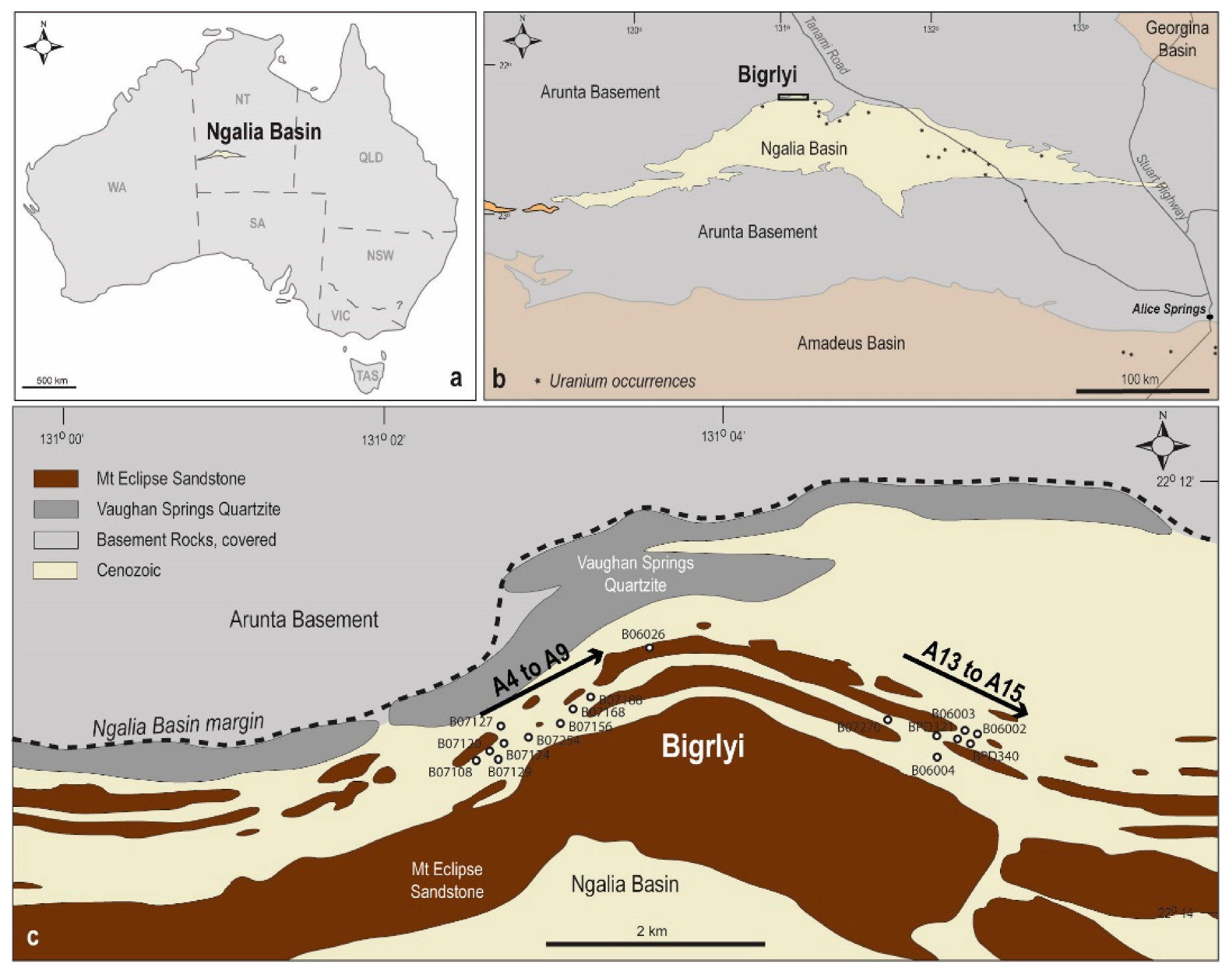
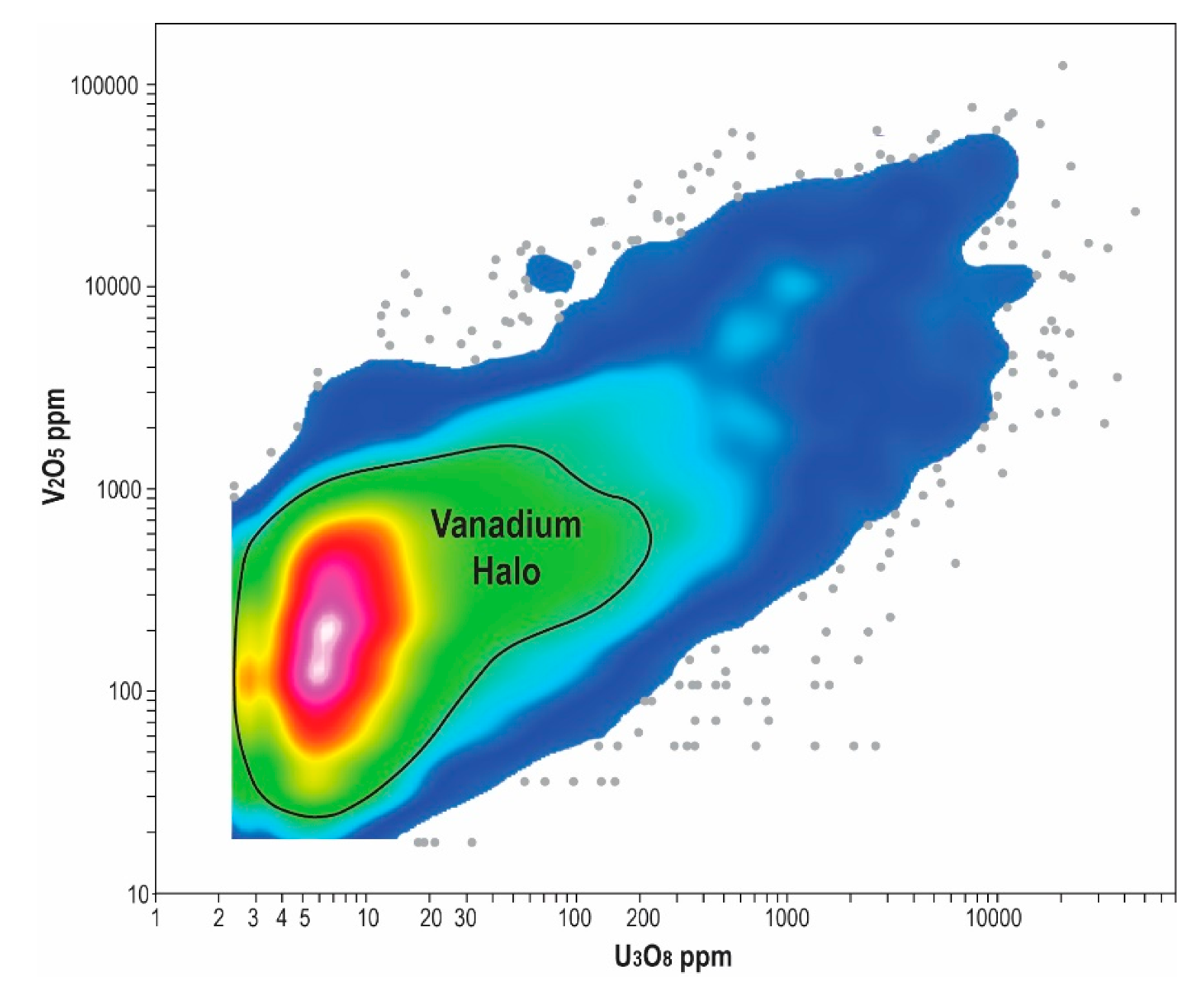



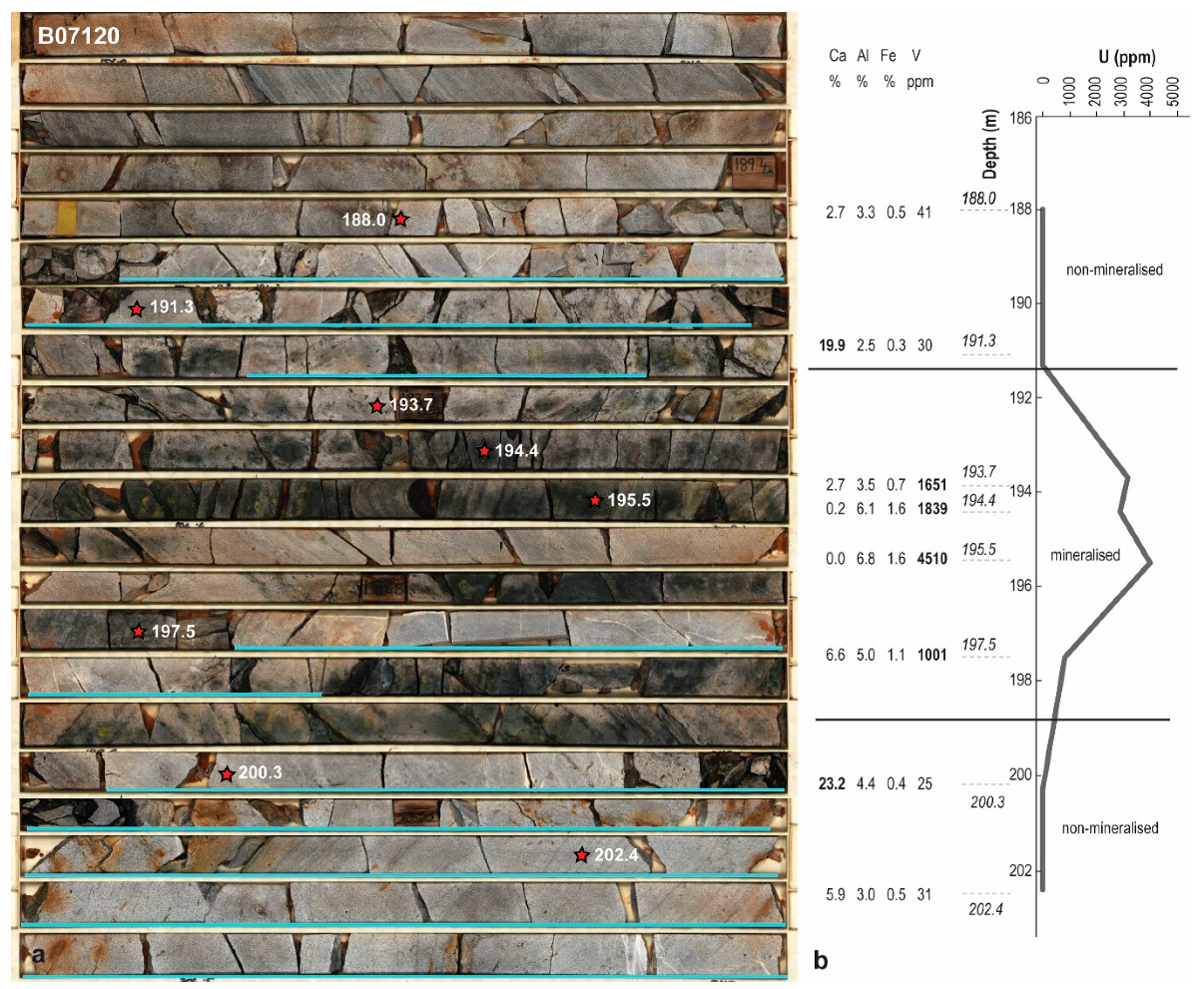

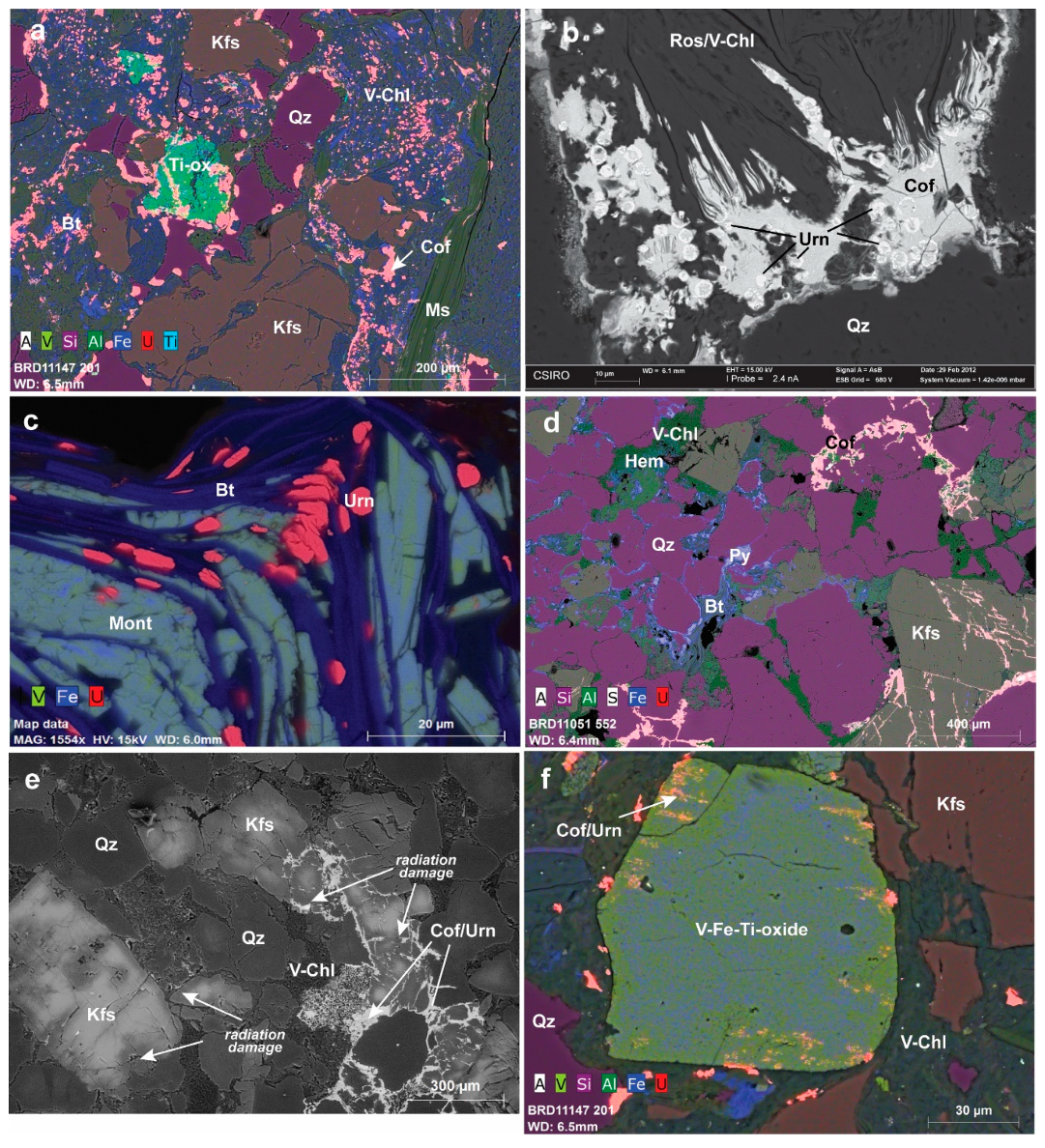

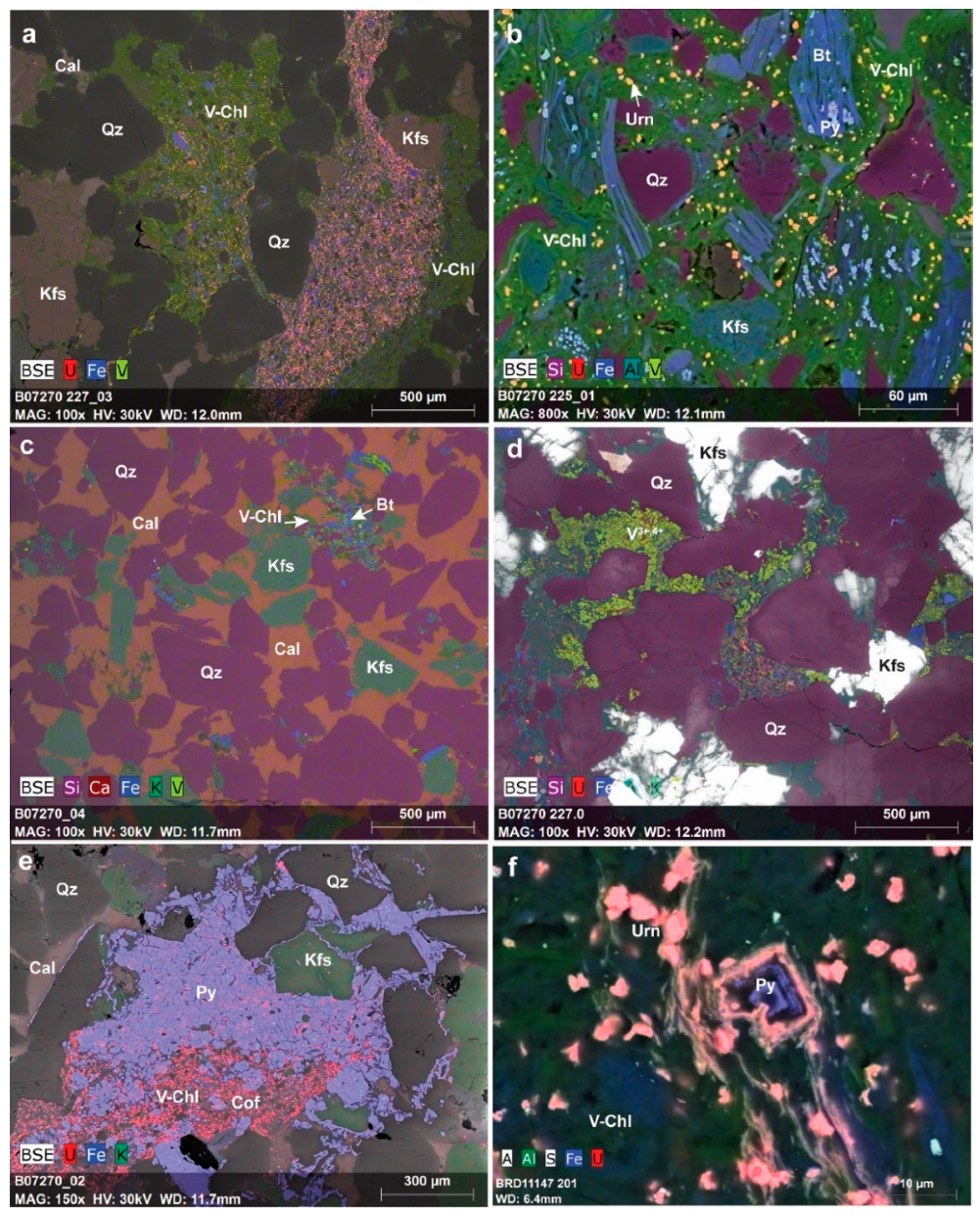
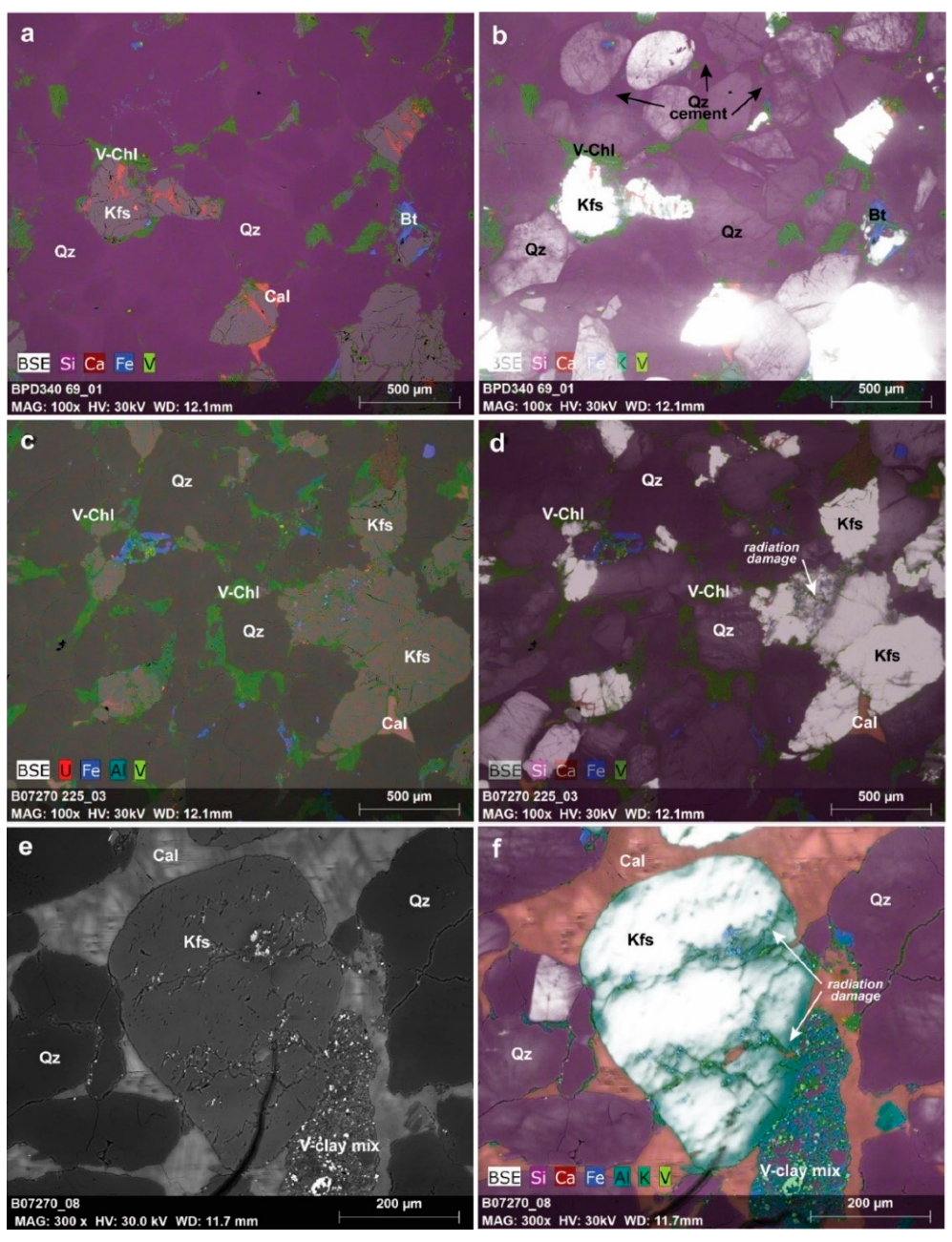
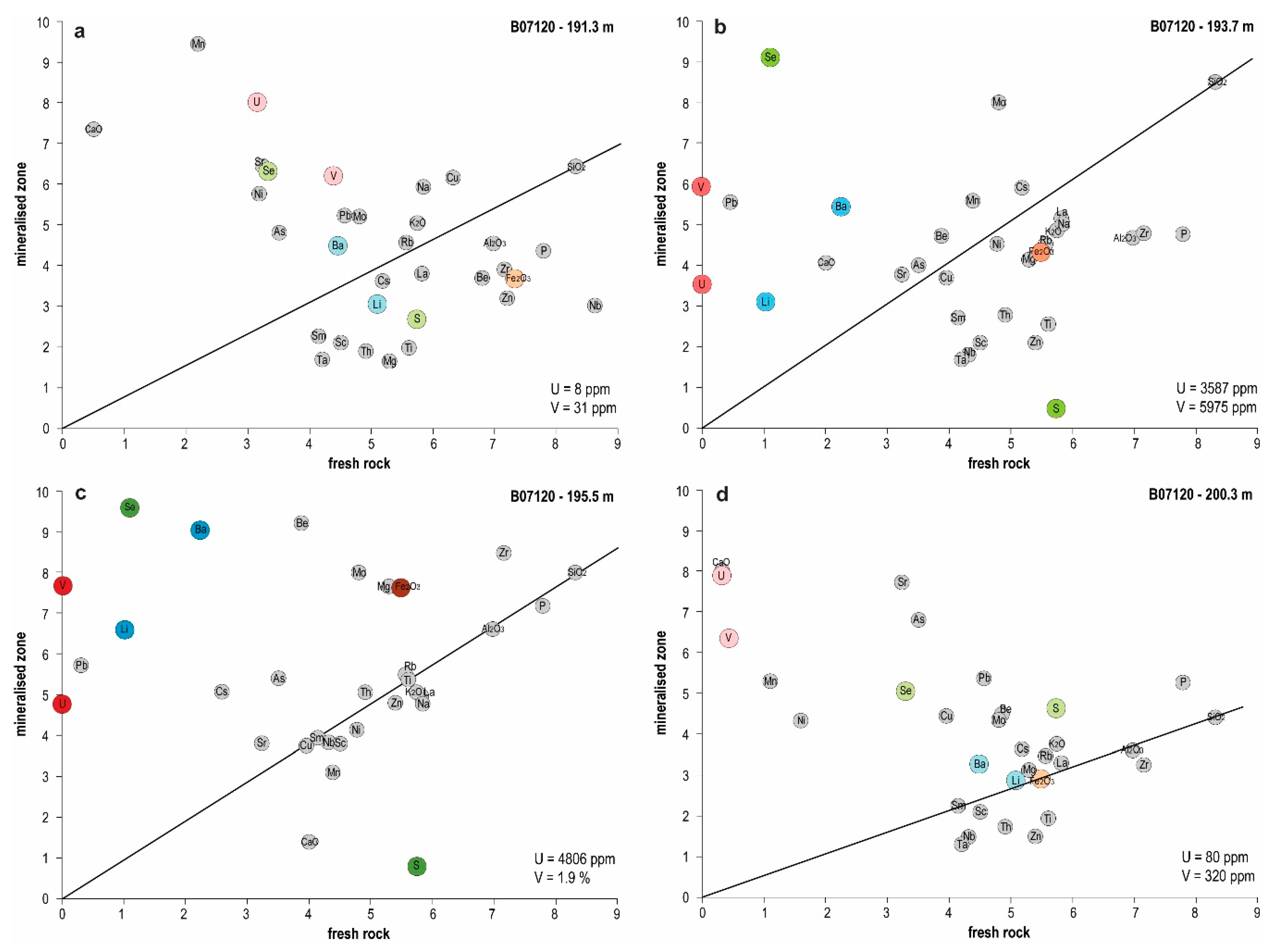
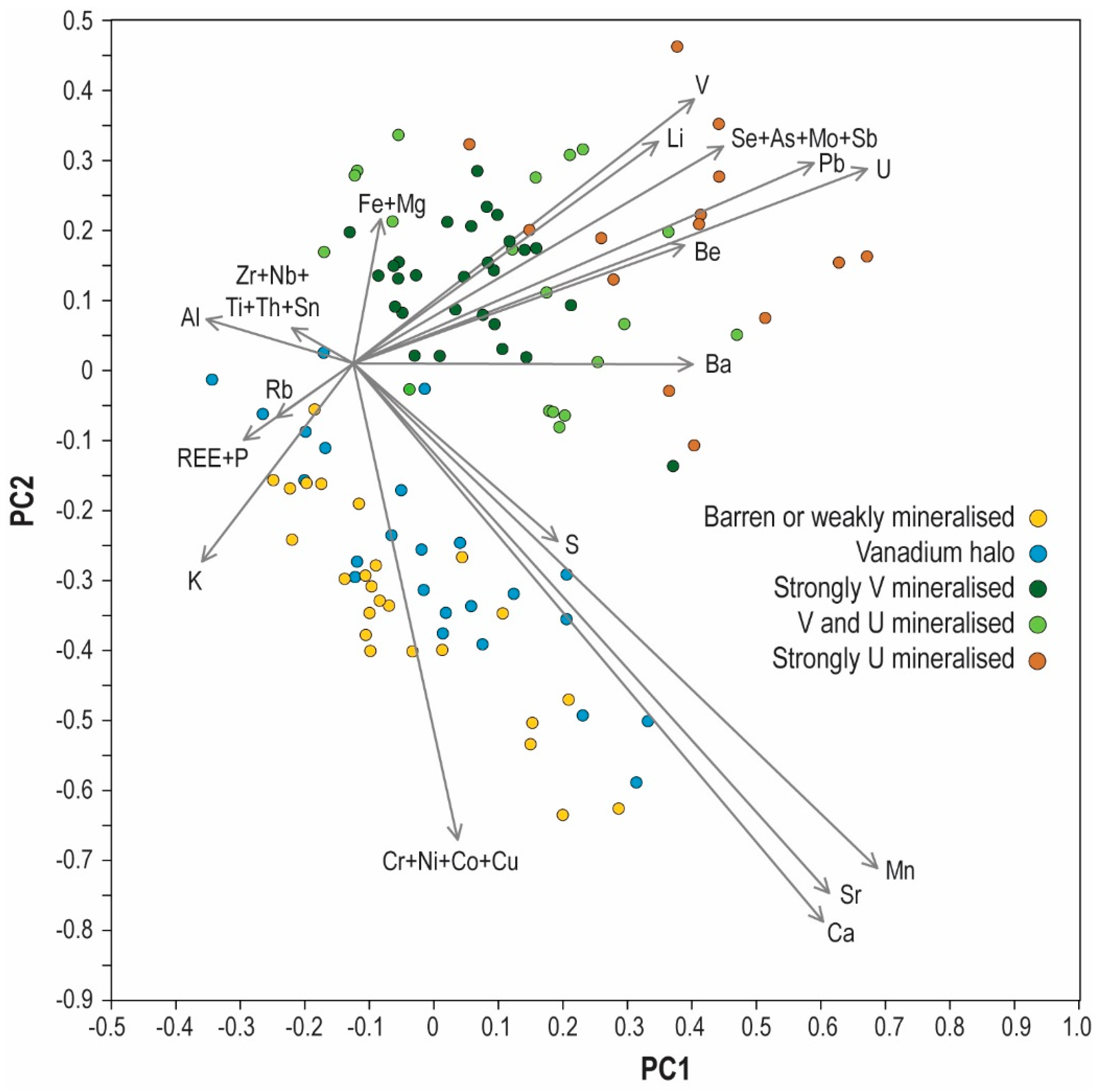
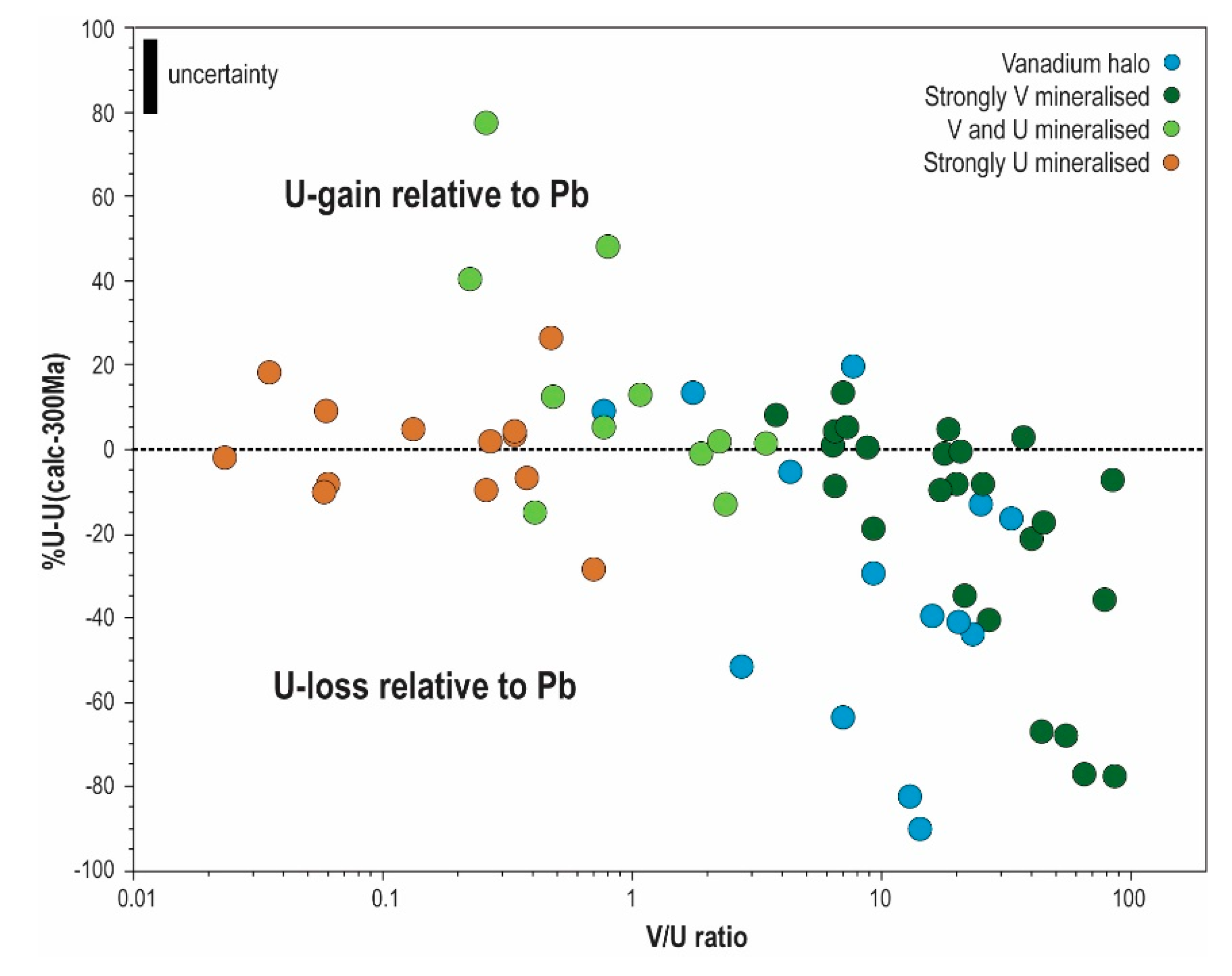
| Mineralization Type | Barren or Weakly Mineralized n = 25 | Vanadium Halo n = 23 | Strongly V-Mineralized n = 28 | U and V-Mineralized n = 19 | Strongly U-Mineralized n = 11 |
|---|---|---|---|---|---|
| V ppm | 20 | 188 | 7716 | 2209 | 1924 |
| U ppm | 5 | 18 | 398 | 2613 | 18,648 |
| Se ppm | 1.5 | 2.0 | 18.9 | 9.8 | 122.1 |
| S ppm | 974 | 294 | 491 | 307 | 541 |
| Se/S | 0.002 | 0.007 | 0.039 | 0.032 | 0.226 |
| Pb ppm | 17 | 20 | 48 | 142 | 960 |
| Li ppm | 7.7 | 11.7 | 28.8 | 27.3 | 40.7 |
| Be ppm | 0.7 | 1.0 | 1.5 | 2.2 | 3.1 |
| Ba ppm | 461 | 473 | 494 | 727 | 1314 |
| K % | 2.33 | 2.32 | 2.23 | 2.19 | 2.35 |
| Al % | 3.04 | 3.22 | 3.48 | 3.48 | 3.43 |
| K/Al | 0.77 | 0.72 | 0.64 | 0.63 | 0.69 |
| Fe + Mg % | 1.34 | 1.97 | 2.56 | 2.04 | 2.47 |
| Cr ppm | 29 | 46 | 15 | 28 | 61 |
| Ca % | 2.27 | 3.12 | 0.47 | 0.50 | 1.09 |
| Rock Type | Sandstone, n = 204 | Siltstone/Shale, n = 36 | Mineralized, >0.1% V, n = 72 ** |
|---|---|---|---|
| C organic % | 0.015 | 0.032 | 0.017 |
| (Range %) | 0.01–0.10 | 0.01–0.46 | 0.01–0.13 |
| C inorganic % | 0.56 | 0.61 | 0.30 |
| V ppm avg. | 459 | 1214 | 5230 |
| Fe % avg. | 0.83 | 1.95 | 1.22 |
| Drill Hole# | Depth (m) | U(ppm) | V(ppm) | Pb(ppm) | V/U | Pb * (ppm) | U/Pb * | U(calc) 300 Ma (ppm) | %U–U(calc) ** |
|---|---|---|---|---|---|---|---|---|---|
| BPD321 | 137.1 | 774 | 15,600 | 62.0 | 20.2 | 42.7 | 18.1 | 842 | −8 |
| BPD321 | 137.95 | 895 | 6290 | 60.9 | 7.0 | 40.1 | 22.3 | 790 | +13 |
| BPD321 | 140.1 | 105 | 8250 | 29.6 | 78.6 | 8.5 | 12.4 | 163 | −36 |
| BPD321 | 141.6 | 651 | 12,000 | 47.4 | 18.4 | 31.4 | 20.7 | 622 | +5 |
| BPD321 | 144.0 | 205 | 5190 | 27.4 | 25.3 | 11.2 | 18.3 | 223 | –8 |
| BPD321 | 144.5 | 239 | 4140 | 33 | 17.3 | 13.2 | 18.1 | 264 | –10 |
| BPD321 | 147.0 | 2460 | 5870 | 159 | 2.4 | 140.1 | 17.6 | 2827 | –13 |
| BPD321 | 148.6 | 206 | 11,300 | 49.8 | 54.9 | 31.8 | 6.5 | 636 | –68 |
| BPD321 | 149.2 | 152 | 9920 | 52.7 | 65.3 | 33.0 | 4.6 | 655 | –77 |
| B07270 | 225.0 | 678 | 4910 | 53.9 | 7.24 | 32.9 | 20.6 | 644 | +5 |
| B07270 | 226.4 | 133 | 4890 | 27.9 | 36.8 | 6.6 | 20.2 | 129 | +3 |
| B07270 | 227.0 | 560 | 4930 | 47.6 | 8.8 | 27.9 | 20.0 | 558 | 0 |
| B07270 | 227.6 | 94 | 4180 | 25.3 | 44.5 | 6.0 | 15.6 | 113 | –17 |
| B07270 | 228.9 | 2610 | 8900 | 145 | 3.4 | 128.3 | 20.3 | 2572 | +2 |
| B07270 | 229.3 | 1250 | 7940 | 86.1 | 6.4 | 62.2 | 20.1 | 1238 | +1 |
| B07270 | 229.7 | 393 | 691 | 35.1 | 1.8 | 17.6 | 22.4 | 347 | +13 |
| Criteria | Bigrlyi |
|---|---|
| Host-rock unit is Silurian or younger in age. | Yes, Carboniferous |
| Host-rock unit was deposited most commonly in fluvial and lacustrine environments in continental settings. | Yes |
| Provenance for sedimentation was commonly granitic or felsic volcanic terranes, either of which provided a plausible source for uranium. | Yes, granitic |
| Fossil carbonized plant matter or humic material is commonly present. | Only plant fossil imprints are present at Bigrlyi, organic matter preservation was poor, and concentrations of organic carbon are low. |
| Uranium concentrations were controlled by sedimentary features rather than tectonic fracture structures. | Yes, fluvial system architecture controls were important at Bigrlyi |
| The host-rock units are those with good regional transmissivity, and the deposits are localized where sandstone/mudstone ratios are near 1:1. | Good transmissivity aquifer characteristics were presumably true for the pre-diagenetic sediments deposited at Bigrlyi, and bounding shale units would have been important in confining the original aquifer in grey sandstone. Although mudstone lithic clasts are important sites for mineralization, overall, mudstone is not as abundant as sandstone in mineralized domains. Loss of permeability and porosity occurred due to early diagenetic carbonate cementation. |
| Low-temperature groundwaters were the mineralizing solutions, rather than high-temperature hypogene fluids. | Yes, but earlier-formed detrital components are also present, some could have been of original hydrothermal origin. |
| The ore minerals are epigenetic even though mineralization was commonly part of diagenesis. | No, mineralization was largely pre-diagenetic and there were detrital components. |
| Mineralization took place in rocks having original low-angle basin-ward dips, and in most cases the deposits were preserved because of only slight increases in regional dip. More severe tectonic events have redistributed ore in some places. | Yes and no, vertical tilting of the host sediments and deformation at the basin margins did not appear to affect the preservation of ore domains at Bigrlyi, but may have initiated and been a driver for U redistribution. |
© 2020 by the authors. Licensee MDPI, Basel, Switzerland. This article is an open access article distributed under the terms and conditions of the Creative Commons Attribution (CC BY) license (http://creativecommons.org/licenses/by/4.0/).
Share and Cite
Schmid, S.; Taylor, W.R.; Jordan, D.P. The Bigrlyi Tabular Sandstone-Hosted Uranium–Vanadium Deposit, Ngalia Basin, Central Australia. Minerals 2020, 10, 896. https://doi.org/10.3390/min10100896
Schmid S, Taylor WR, Jordan DP. The Bigrlyi Tabular Sandstone-Hosted Uranium–Vanadium Deposit, Ngalia Basin, Central Australia. Minerals. 2020; 10(10):896. https://doi.org/10.3390/min10100896
Chicago/Turabian StyleSchmid, Susanne, Wayne R. Taylor, and Daniel P. Jordan. 2020. "The Bigrlyi Tabular Sandstone-Hosted Uranium–Vanadium Deposit, Ngalia Basin, Central Australia" Minerals 10, no. 10: 896. https://doi.org/10.3390/min10100896
APA StyleSchmid, S., Taylor, W. R., & Jordan, D. P. (2020). The Bigrlyi Tabular Sandstone-Hosted Uranium–Vanadium Deposit, Ngalia Basin, Central Australia. Minerals, 10(10), 896. https://doi.org/10.3390/min10100896





